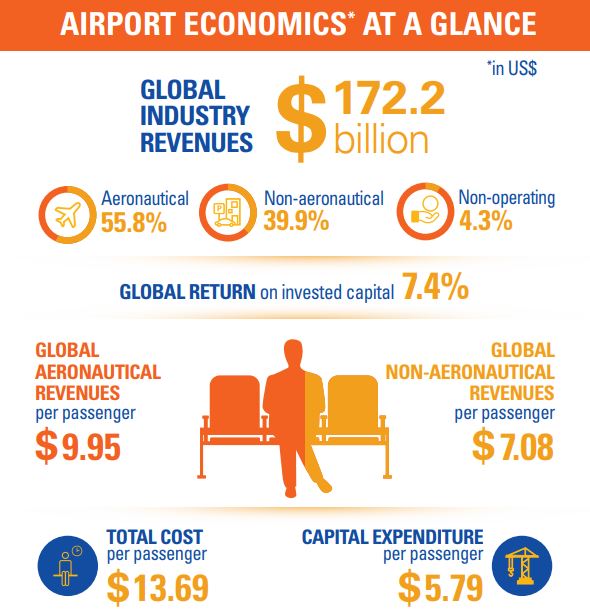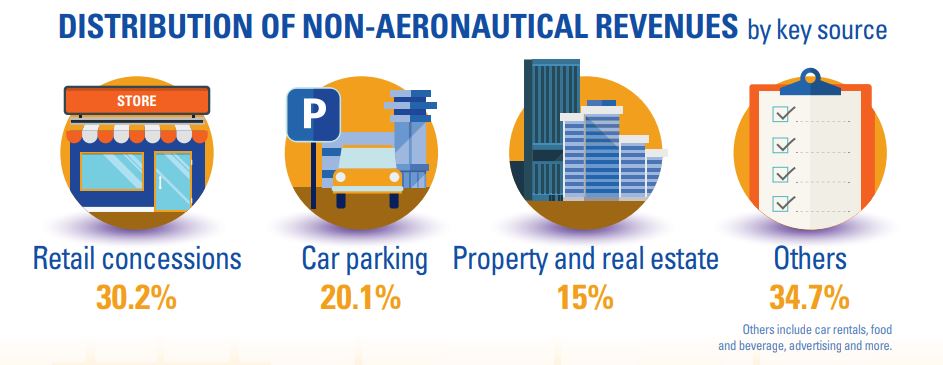
INTERNATIONAL. Airports Council International (ACI) has released the latest edition of its Airport Economics Report, outlining the industry’s key performance indicators for financial year 2017.
Global airport revenues grew 6.2% to reach US$172.2 billion, with non-aeronautical revenue accounting for 39.9% of the total. This compares to 55.8% for aeronautical revenue, and 4.3% for non-operating revenue.
ACI said the total cost per passenger for airports (US$13.69) exceeded global aeronautical revenues per passenger (US$9.95), “illustrating once again the importance of non-aeronautical revenues for airports’ financial sustainability”. Global non-aeronautical revenue per passenger was US$7.08.
Retail concessions remain the largest source of non-aeronautical revenue for airports at 30.2%. Car parking revenue and property revenue/rent are the second and third largest sources of non-aeronautical revenues at 20.1% and 15.0% respectively, the study showed.
Global passenger traffic was up 7.5%, remaining strong at airports in both advanced and emerging economies over the course of the year, ACI said. Annual growth rates were above historical averages, despite downside risks to the global economy.
ACI said this performance was bolstered by the continued recovery in manufacturing and global trade, alongside a rise in business confidence, fostering confidence, investment, and growth in airports across the world.
In 2017, airports located in emerging and developing economies represented 46% of global passenger traffic across the world’s airports. ACI said emerging markets and developing economies are predicted to surpass advanced economies after 2022. By 2040, their share is expected to increase to 60%.

Source: ACI World.
The Asia Pacific market continues to lead global growth with most of the world’s fastest-growing large airports. Sixteen of the fastest-growing top 30 airports with more than 15 million passengers are located in just two countries, China and India.
Europe’s largest aviation markets continue to make positive strides in passenger traffic, ACI noted, with the region achieving record-breaking 8.8% annual growth in 2017. Strong overall business and consumer confidence, coupled with low fares from many carriers, stimulated demand and boosted the propensity for air travel in the region.
However, 80% of airports in the world have fewer than a million passengers per annum and 94% of these are loss-making.
The report is based on data from more than 900 airports, representing 78% of worldwide passenger traffic. It was launched ahead of the ACI Asia-Pacific/World Annual General Assembly, Conference and Exhibition being held at the AsiaWorld-Expo in Hong Kong, hosted by Hong Kong International Airport. ACI said aviation leaders would discuss many of the report’s themes and findings there.

Source: ACI World.
ACI World Director General Angela Gittens commented: “Steady growth since 2010 is testament to the resilience of our industry and shows that airports continue to serve as growth engines and critical contributors to global trade. Passenger traffic remains on an upward trajectory across the globe and airports are responding to demand in both advanced and emerging economies.
“At the same time, airport operators face capacity constraints and, with our global medium-term forecast showing almost 30% growth in passenger numbers from 2017 to 2022, many national governments face the predicament of surging air transport demand outstripping available airport infrastructure.
“If we are to continue to keep pace with this demand airports must be able to invest, improve and grow. Charges for services rendered to airport users and non-aeronautical revenues are the major sources of funds for airports to invest in infrastructure and service improvements and efforts to irrationally restrict or regulate these things should be avoided.
“Generating a positive economic return depends on sound, strategic planning with appropriate financing mechanisms. There is no one-size fits all approach and airports must take a long-term perspective to their business and ensure capacity improvements.”












